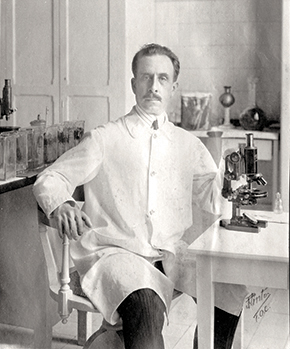
Casa de Oswaldo Cruz Collection, Department of Archives and DocumentationChagas supports a sick child in the film he made in 1910 and exhibited at the ANM and in DresdenCasa de Oswaldo Cruz Collection, Department of Archives and Documentation
The solemn session of the National Academy of Medicine (ANM) in Rio de Janeiro on October 31, 1910, featured a number of new developments, all of which entered into the history of the 185-year-old institution. The first was the admission of Carlos Chagas, a physician and researcher from the Oswaldo Cruz Institute (IOC), to membership of the ANM even though there were no openings, an unprecedented occurrence. The invitation had come from the academy’s president, Miguel Pereira who, months before, with other academy members had visited the region of Minas Gerais where Chagas discovered the disease that would later come to be known by his name. The second new development was that it was at that session that the researcher gave his first lecture about the disease to his peers. On that same day, electric lighting was inaugurated in Rio. Lastly, the newest member of the academy showed a nine-minute film depicting patients from the city of Lassance (MG), in order to illustrate his concern about the deterioration of human health caused by the Trypanossoma cruzi parasite. The film, now entitled Chagas em Lassance (Chagas in Lassance), is one of the first scientific documentaries produced in Brazil.
Oswaldo Cruz Foundation (Fiocruz) researchers Stella Oswaldo Cruz Penido and Eduardo Vilela Thielen, who are also film directors, started to look for Chagas em Lassance in the early 1990s. “It was during the production of another documentary, Chagas do Brasil (Chagas of Brazil), that we heard about those films by Chagas, Penido says. “We started searching the available archives, and our search under Carlos Chagas Filho turned up a 16 mm film done by his father in 1910, which was restored and later digitized.”

Casa de Oswaldo Cruz Collection, Department of Archives and DocumentationThe researcher walks toward the hospital in LassanceCasa de Oswaldo Cruz Collection, Department of Archives and Documentation
The two then produced and directed Cinematógrafo brasileiro em Dresden (A Brazilian Cinematographer in Dresden), which runs 21 minutes. This was in 2011, one hundred years after Chagas em Lassance had been exhibited at the International Exposition of Hygiene held in Dresden, Germany. The documentary features depositions by researchers about the campaigns against yellow fever led by Oswaldo Cruz in Rio, shows clips from a film by an unknown filmmaker who recorded those activities during the first decade of the 20th century, and tells of the reactions to Chagas em Lassance when it was shown on several occasions at the German exposition to a varied European audience.
“The film must have been made with a French or German crank-operated wooden camera, running 16 frames a second, using a fixed-focus lens and black-and-white film,” is the conclusion by Hernani Heffner, chief conservator at the Cinemateca of the Museum of Modern in Rio, speaking in Cinematógrafo brasileiro em Dresden. “Showing those patients in a such a natural and direct manner, hiding nothing, was being absolutely candid with the audience.”

Casa de Oswaldo Cruz Collection, Department of Archives and DocumentationPosing for a photo in his laboratory in 1929Casa de Oswaldo Cruz Collection, Department of Archives and Documentation
Carlos Chagas makes a very brief appearance in the film, wearing a white suit and a hat, supporting a child who was trying to stand [photo on page __]. The images show children and young people who suffered from neurological impairments and had trouble with motor skills. Chagas called those problems “a nervous form of American trypanosomiasis.” At the time, both Chagas disease and goiter were occurring in the same locality. Goiter resulted from the lack of iodine in regions far from the ocean, and affected the nervous system and young brains of children,” explains José Rodrigues Coura, head of the Parasitical Disease Laboratory at the IOC. “The combination of the two diseases led the great scientist to confuse them.”
Simone Kropf, science historian at the Casa de Oswaldo Cruz/Fiocruz, recalls that she was touched by the scenes in the film where children try unsuccessfully to stand. “The idea that this situation was caused by preventable diseases introduced a new perspective into the debate about public health: Brazil can be cured, we are not condemned to backwardness, and it is possible, through science, to overcome that situation,” Kropf says, speaking in Penido and Thielen’s film.
Chagas’s film was not intended to be sensational. It was important to bring pictures of patients from Brazil’s interior regions and show them in the federal capital. Oswaldo Cruz knew that, and being an aficionado of photography, he had hired a photographer, J. Pinto, to work at the IOC. The wealth of iconographic material produced since the early years of the Institute resulted in a book Vida, engenho e arte – O acervo histórico da Fundação Oswaldo Cruz (Life, Ingenuity, and Art – the Historical Collection of the Oswaldo Cruz Foundation) (COC/Fiocruz, 2014), compiled by Fábio Iglesias, Paulo Roberto Elian dos Santos, and Ruth B. Martins. The work includes photos of the construction of the castle at Manguinhos, scenes and personages from the history of the Foundation, collections, and a photogram of Chagas em Lassance that is an extremely rare example of an antique Brazilian scientific film.
Republish
